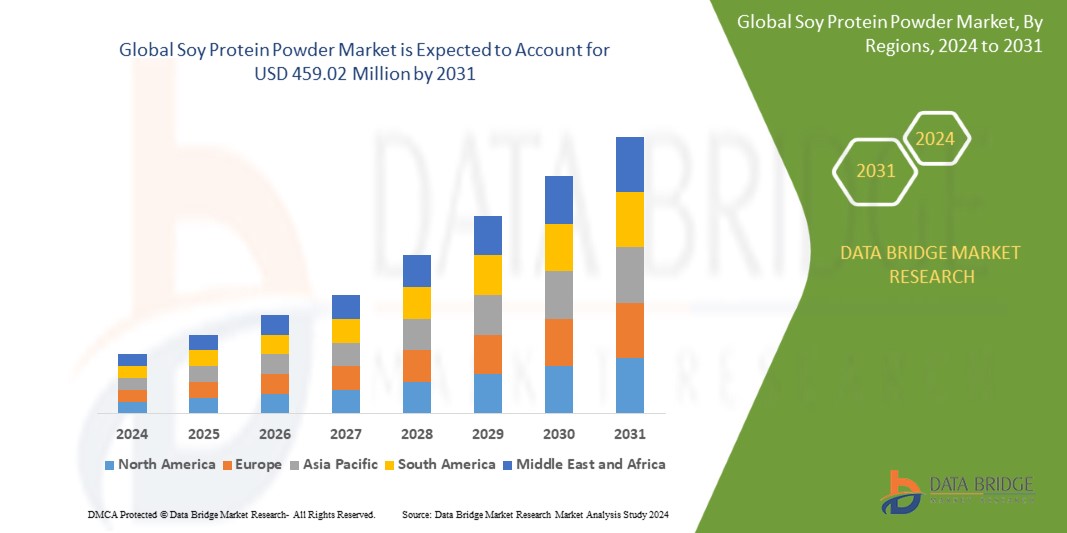世界の大豆タンパク質粉末市場の規模、シェア、トレンド分析レポート
Market Size in USD Billion
CAGR :
% 
| 2024 –2031 | |
| USD 299.10 Million | |
| USD 459.02 Million | |
|
|
|
>世界の大豆タンパク質粉末市場のセグメンテーション、製品タイプ(分離、濃縮、その他)、性質(有機および従来)、用途(食品および飲料、医薬品、動物飼料、その他)– 2031年までの業界動向と予測
大豆プロテインパウダー市場分析
世界の大豆タンパク質粉末市場は、植物由来の食事の人気が高まり、消費者の健康志向が高まっていることから、堅調な成長を遂げています。アジア太平洋地域は、さまざまな食品用途で大豆タンパク質が受け入れられていることを反映して、主要な成長地域として浮上しています。さらに、市場は、肉代替品、乳製品代替品、栄養補助食品など、さまざまな用途の恩恵を受けています。大豆価格の変動や他の植物性タンパク質との競争などの課題に直面しているにもかかわらず、製品配合の革新の増加とクリーンラベル製品への傾向の高まりは、業界関係者に大きな成長の機会を提供します。
大豆プロテインパウダー市場規模
世界の大豆タンパク質粉末市場規模は、2023年に2億9,910万米ドルと評価され、2024年から2031年の予測期間中に5.5%のCAGRで成長し、2031年には4億5,902万米ドルに達すると予測されています。市場価値、成長率、セグメンテーション、地理的範囲、主要プレーヤーなどの市場シナリオに関する洞察に加えて、Data Bridge Market Researchがまとめた市場レポートには、輸出入分析、生産能力概要、生産消費分析、価格動向分析、気候変動シナリオ、サプライチェーン分析、バリューチェーン分析、原材料/消耗品概要、ベンダー選択基準、PESTLE分析、ポーター分析、規制枠組みも含まれています。
大豆プロテインパウダーのトレンド
「植物由来の食事に対する消費者の嗜好の高まり」
世界の大豆タンパク質粉末市場では、将来を形作るいくつかの重要なトレンドが見られます。 1 つの顕著なトレンドは、健康志向と環境への懸念から、植物ベースの食事に対する消費者の嗜好が高まっていることです。 この変化により、持続可能なタンパク質源としての大豆タンパク質の需要が高まり、特にビーガンやベジタリアンの間で高まっています。 さらに、スポーツ栄養部門の成長が市場を活気づけており、アスリートやフィットネス愛好家は、パフォーマンスと回復を高めるためにタンパク質サプリメントを求めています。 フレーバー付きですぐに飲める大豆タンパク質飲料の開発など、製品配合の革新も勢いを増しており、より幅広い層の人々にアピールしています。 さらに、クリーン ラベル運動により、メーカーは非 GMO およびオーガニックの大豆タンパク質のオプションを提供するよう促され、透明性と消費者の信頼が高まっています。 最後に、e コマース プラットフォームの拡大により、大豆タンパク質製品が消費者にとってより入手しやすくなり、市場の成長がさらに促進されています。 これらのトレンドは、大豆タンパク質粉末の市場環境がダイナミックかつ進化していることを示しています。
レポートの範囲と市場セグメンテーション
|
属性 |
大豆プロテインパウダーの主要市場分析 |
|
セグメンテーション |
|
|
対象国 |
米国、カナダ、メキシコ、ドイツ、フランス、英国、オランダ、スイス、ベルギー、ロシア、イタリア、スペイン、トルコ、その他のヨーロッパ諸国、中国、日本、インド、韓国、シンガポール、マレーシア、オーストラリア、タイ、インドネシア、フィリピン、その他のアジア太平洋諸国、サウジアラビア、UAE、南アフリカ、エジプト、イスラエル、その他の中東およびアフリカ諸国、ブラジル、アルゼンチン、その他の南米諸国 |
|
主要な市場プレーヤー |
ADM(米国)、カーギル社(米国)、不二製油グループ本社(日本)、ファーベスト(米国)、ケリーグループ(アイルランド)、バトリーフード(米国)、CHS社(米国)、クラウンソヤプロテイングループカンパニー(カナダ)、ザ・スコーラ社(米国)、フードケムインターナショナル(米国)、ニュートラフードイングリディエンツ社(米国)、オーセージフードプロダクツ社(米国)、デュポン社(米国)、ネスレ(スイス) |
|
市場機会 |
|
|
付加価値データ情報セット |
Data Bridge Market Research がまとめた市場レポートには、市場価値、成長率、セグメンテーション、地理的範囲、主要プレーヤーなどの市場シナリオに関する洞察に加えて、輸出入分析、生産能力の概要、生産消費分析、価格動向分析、気候変動シナリオ、サプライ チェーン分析、バリュー チェーン分析、原材料/消耗品の概要、ベンダー選択基準、PESTLE 分析、ポーター分析、規制枠組みも含まれています。 |
大豆プロテインパウダーの定義
大豆プロテインパウダーは、大豆由来の高品質な植物性タンパク質で、タンパク質摂取量を増やすための栄養補助食品としてよく使用されます。脱脂大豆粉からタンパク質を抽出して作られ、必須アミノ酸を豊富に含む粉末となり、動物性タンパク質に匹敵する完全なタンパク質源となります。大豆プロテインパウダーは、スポーツ栄養、食事代替品、プロテインバー、シェイク、焼き菓子などの食品など、さまざまな用途に広く使用されています。
大豆プロテインパウダー市場の動向
ドライバー
- 植物由来の食事に対する需要の高まり
世界の大豆タンパク質パウダー市場は、いくつかの重要な要因によって牽引されています。まず、植物ベースの食事に対する需要の高まりが成長の大きな要因となっています。消費者が健康志向や環境意識が高まるにつれ、大豆タンパク質を含む植物ベースのタンパク質源へとシフトしています。この傾向は、動物性タンパク質に代わる栄養価が高く持続可能な代替品を求めるベジタリアン、ビーガン、フレキシタリアンの間で特に顕著です。大豆タンパク質パウダーは、完全なアミノ酸プロファイルを提供するだけでなく、さまざまな健康上の利点も提供するため、魅力的な選択肢となっています。たとえば、植物ベースの食事の世界的な急増は、健康意識の高まりと環境への懸念によって推進されています。2022年には、植物ベースのタンパク質代替品の市場は122億米ドルと評価され、2022年から2027年までの年間成長率は7.3%と予測されています。心臓病やがんのリスク軽減などの健康上の利点や、動物農業の環境への影響に対する消費者の意識が高まるにつれ、植物ベースのタンパク質への関心が高まっています。
- 食品業界での応用拡大
食品および飲料業界で大豆タンパク質粉末の用途が拡大していることが、市場の成長を牽引しています。大豆タンパク質は、栄養バー、プロテインシェイク、肉代替品、焼き菓子など、さまざまな製品でますます使用されています。大豆タンパク質の汎用性により、メーカーは製品の栄養プロファイルを強化しながら、より健康的な選択肢を求める消費者の需要を満たすことができます。さらに、スポーツ栄養製品の人気の高まりにより、アスリートやフィットネス愛好家が筋肉の回復とパフォーマンスの向上に効果的なタンパク質源を求めているため、大豆タンパク質の需要がさらに高まっています。
機会
- 健康上の利点に対する意識の高まり
大豆タンパク質パウダーに関連する健康上の利点に対する認識が高まっていることは、市場拡大の大きな機会を示しています。消費者は、心臓の健康、体重管理、筋肉増強をサポートする能力など、大豆タンパク質の栄養上の利点をますます認識しています。研究によると、大豆タンパク質はコレステロール値を下げ、心臓血管の健康全体を改善することができます。健康志向の消費者が健康目標に一致するタンパク質源を求めるようになると、ブランドは機能性スナックやタンパク質強化飲料など、新しい大豆タンパク質ベースの製品を開発することでこの傾向を利用できます。さらに、大豆タンパク質の利点を強調する教育キャンペーンは、消費者の知識を高め、需要を喚起し、企業が競争の激しい市場で自社の製品を差別化できるようにします。たとえば、2019年4月に国立医学図書館が発表した研究記事によると、研究により、大豆タンパク質はLDLコレステロール値を大幅に下げることができ、大豆ベースの製品に対する消費者の関心が高まっていることが示されています。大豆タンパク質を組み込んだビヨンド・ミートやインポッシブル・フーズなどの肉代替品の需要は、より健康的なタンパク質源への移行を示しており、大豆タンパク質の健康上の利点に対する認識が高まっていることを示しています。
- 製品開発におけるイノベーション
製品開発におけるイノベーションは、大豆タンパク質粉末市場に大きなチャンスをもたらします。消費者の嗜好が進化するにつれ、多様で便利な大豆タンパク質ベースの製品に対する需要が高まっています。企業は、すぐに飲めるプロテインシェイク、タンパク質強化スナック、大豆タンパク質を注入した焼き菓子など、革新的な配合を模索し、忙しいライフスタイルに応えることができます。さらに、食品技術の進歩により、風味プロファイルと食感が改善され、大豆タンパク質はより幅広い層にアピールするようになります。食品科学者や料理の専門家とのコラボレーションにより、消費者の関心を引くユニークで高品質な製品を生み出すことができます。さらに、調達と生産における持続可能性に重点を置くブランドは、環境意識の高い消費者の共感を呼び、ブランドロイヤルティと市場での地位を高めます。
制約/課題
- 原材料価格の変動
世界の大豆タンパク質粉末市場が直面している大きな課題の 1 つは、原材料価格の変動です。大豆は、気象条件、サプライ チェーンの混乱、農業政策の変更など、さまざまな要因により価格が変動します。たとえば、米国やブラジルなどの主要な大豆生産国で悪天候が発生すると、収穫量が減り、大豆の価格が急騰する可能性があります。この変動は、大豆タンパク質粉末メーカーの生産コストに直接影響し、製品の安定した価格を維持することが困難になります。その結果、企業は競合他社に市場シェアを奪われることなく、消費者にコストを転嫁するのに苦労する可能性があります。単一の商品への依存、潜在的な貿易関税、地政学的緊張が、問題をさらに悪化させます。この予測不可能性により、セクターの長期計画と投資が妨げられ、最終的には成長の見通しと収益性に影響する可能性があります。
- 代替タンパク質との競争
世界の大豆タンパク質粉末市場は、エンドウ豆、米、麻タンパク質など、さまざまな代替タンパク質源との厳しい競争に直面しています。植物ベースの食事の人気が高まるにつれて、消費者はますます多様なタンパク質の選択肢を模索しています。たとえば、エンドウ豆タンパク質は、アレルギーに配慮したプロファイルと好ましいアミノ酸プロファイルにより人気が高まり、健康志向の消費者にとって実行可能な代替品として位置付けられています。Pea Protein Co. などのブランドは、この需要に応える革新的な製品を生み出しており、既存の大豆タンパク質メーカーに挑戦しています。
この市場レポートでは、最近の新しい開発、貿易規制、輸出入分析、生産分析、バリュー チェーンの最適化、市場シェア、国内および現地の市場プレーヤーの影響、新たな収益源の観点から見た機会の分析、市場規制の変更、戦略的市場成長分析、市場規模、カテゴリ市場の成長、アプリケーションのニッチと優位性、製品の承認、製品の発売、地理的拡大、市場における技術革新などの詳細が提供されます。市場に関する詳細情報を取得するには、アナリスト ブリーフについて Data Bridge Market Research にお問い合わせください。当社のチームが、情報に基づいた市場決定を行い、市場の成長を実現できるようお手伝いします。
原材料不足と出荷遅延の影響と現在の市場シナリオ
Data Bridge Market Research は、市場の高水準な分析を提供し、原材料不足や出荷遅延の影響と現在の市場環境を考慮した情報を提供します。これは、戦略的な可能性を評価し、効果的な行動計画を作成し、企業が重要な決定を下すのを支援することにつながります。
標準レポートの他に、予測される出荷遅延からの調達レベルの詳細な分析、地域別の販売代理店マッピング、商品分析、生産分析、価格マッピングの傾向、調達、カテゴリパフォーマンス分析、サプライチェーンリスク管理ソリューション、高度なベンチマーク、その他の調達および戦略サポートのサービスも提供しています。
経済減速が製品の価格と入手可能性に及ぼす予想される影響
経済活動が減速すると、業界は打撃を受け始めます。DBMR が提供する市場洞察レポートとインテリジェンス サービスでは、景気後退が製品の価格設定と入手しやすさに及ぼす予測される影響が考慮されています。これにより、当社のクライアントは通常、競合他社より一歩先を行き、売上と収益を予測し、損益支出を見積もることができます。
世界の大豆タンパク質粉末市場の展望
市場は、製品の種類、性質、用途に基づいてセグメント化されています。これらのセグメント間の成長は、業界のわずかな成長セグメントを分析するのに役立ち、ユーザーに貴重な市場の概要と市場の洞察を提供し、コア市場アプリケーションを特定するための戦略的決定を下すのに役立ちます。
製品タイプ
- 隔離する
- 集中
- その他
自然
- オーガニック
- 従来の
応用
- 食品・飲料
- 医薬品
- 動物飼料
- その他
世界の大豆タンパク質粉末の地域分析
市場は分析され、上記の製品タイプ、性質、アプリケーション別に市場規模の洞察と傾向が提供されます。
市場に含まれる国は、米国、カナダ、メキシコ、ドイツ、フランス、英国、オランダ、スイス、ベルギー、ロシア、イタリア、スペイン、トルコ、その他のヨーロッパ諸国、中国、日本、インド、韓国、シンガポール、マレーシア、オーストラリア、タイ、インドネシア、フィリピン、その他のアジア太平洋諸国、サウジアラビア、UAE、南アフリカ、エジプト、イスラエル、その他の中東およびアフリカ諸国、ブラジル、アルゼンチン、その他の南米諸国です。
アジア太平洋地域は、いくつかの説得力のある要因により、世界の大豆タンパク質粉末市場を支配すると予想されており、最も急速に成長する地域でもあります。この地域では、可処分所得の増加と都市化に牽引され、消費者の健康意識が大幅に高まり、植物ベースの食事への移行が見られてきました。中国やインドなどの国では、特に増加する中流階級の間で、タンパク質を豊富に含む食品の需要が急増しています。第二に、加工食品やタンパク質サプリメントの成長を含むアジア太平洋地域の食品および飲料業界の拡大により、主要成分としての大豆タンパク質粉末の需要が高まっています。
レポートの国別セクションでは、市場の現在および将来の傾向に影響を与える国内市場における個別の市場影響要因と規制の変更も提供しています。下流および上流のバリュー チェーン分析、技術動向、ポーターの 5 つの力の分析、ケース スタディなどのデータ ポイントは、個々の国の市場シナリオを予測するために使用される指標の一部です。また、国別データの予測分析を提供する際には、グローバル ブランドの存在と可用性、および地元および国内ブランドとの競争が激しいか少ないために直面する課題、国内関税と貿易ルートの影響も考慮されます。
大豆プロテインパウダーの世界市場シェア
市場競争環境では、競合他社の詳細が提供されます。含まれる詳細には、会社概要、会社の財務状況、収益、市場の可能性、研究開発への投資、新しい市場への取り組み、世界的なプレゼンス、生産拠点と施設、生産能力、会社の強みと弱み、製品の発売、製品の幅と広さ、アプリケーションの優位性などがあります。提供される上記のデータ ポイントは、市場に関連する会社の焦点にのみ関連しています。
市場で活躍する大豆プロテインパウダーのリーダーは次のとおりです。
- アーチャー・ダニエルズ・ミッドランド(米国)
- カーギル社(米国)
- 不二製油グループ本社株式会社(日本)
- ファーベスト(米国)
- ケリー(アイルランド)
- バトリーフード(米国)
- CHS Inc.(米国)
- クラウン ソヤ プロテイン グループ EI(カナダ)
- スクーラー・カンパニー(米国)
- フードケムインターナショナル(米国)
- ニュートラフードイングリディエンツLLC(米国)
- オセージ食品(米国)
- デュポン・ド・ネムール社(米国)
- ネスレ(スイス)
大豆プロテインパウダー市場の最新動向
- 2024年、WKケロッグ社は、Z世代の食のトレンドにアピールするために、新しいシリアルブランド「Eat Your Mouth Off」を通じてビーガン分野に参入した。
- 2023年、ネスレは同社初となる手頃な価格で栄養価の高いインスタントプロテインパウダーを西アフリカと中央アフリカで発売した。このパウダーは牛乳と植物原料をブレンドして作られている。
SKU-
世界初のマーケットインテリジェンスクラウドに関するレポートにオンラインでアクセスする
- インタラクティブなデータ分析ダッシュボード
- 成長の可能性が高い機会のための企業分析ダッシュボード
- カスタマイズとクエリのためのリサーチアナリストアクセス
- インタラクティブなダッシュボードによる競合分析
- 最新ニュース、更新情報、トレンド分析
- 包括的な競合追跡のためのベンチマーク分析のパワーを活用
調査方法
データ収集と基準年分析は、大規模なサンプル サイズのデータ収集モジュールを使用して行われます。この段階では、さまざまなソースと戦略を通じて市場情報または関連データを取得します。過去に取得したすべてのデータを事前に調査および計画することも含まれます。また、さまざまな情報ソース間で見られる情報の不一致の調査も含まれます。市場データは、市場統計モデルと一貫性モデルを使用して分析および推定されます。また、市場シェア分析と主要トレンド分析は、市場レポートの主要な成功要因です。詳細については、アナリストへの電話をリクエストするか、お問い合わせをドロップダウンしてください。
DBMR 調査チームが使用する主要な調査方法は、データ マイニング、データ変数が市場に与える影響の分析、および一次 (業界の専門家) 検証を含むデータ三角測量です。データ モデルには、ベンダー ポジショニング グリッド、市場タイムライン分析、市場概要とガイド、企業ポジショニング グリッド、特許分析、価格分析、企業市場シェア分析、測定基準、グローバルと地域、ベンダー シェア分析が含まれます。調査方法について詳しくは、お問い合わせフォームから当社の業界専門家にご相談ください。
カスタマイズ可能
Data Bridge Market Research は、高度な形成的調査のリーダーです。当社は、既存および新規のお客様に、お客様の目標に合致し、それに適したデータと分析を提供することに誇りを持っています。レポートは、対象ブランドの価格動向分析、追加国の市場理解 (国のリストをお問い合わせください)、臨床試験結果データ、文献レビュー、リファービッシュ市場および製品ベース分析を含めるようにカスタマイズできます。対象競合他社の市場分析は、技術ベースの分析から市場ポートフォリオ戦略まで分析できます。必要な競合他社のデータを、必要な形式とデータ スタイルでいくつでも追加できます。当社のアナリスト チームは、粗い生の Excel ファイル ピボット テーブル (ファクト ブック) でデータを提供したり、レポートで利用可能なデータ セットからプレゼンテーションを作成するお手伝いをしたりすることもできます。





